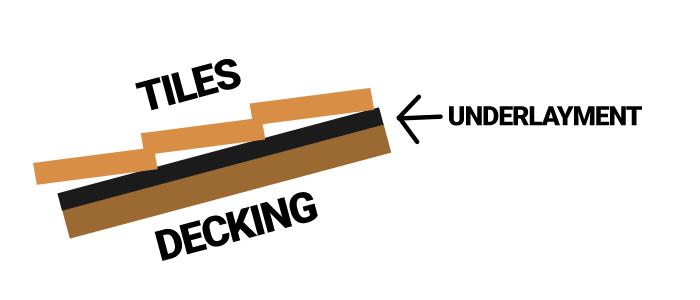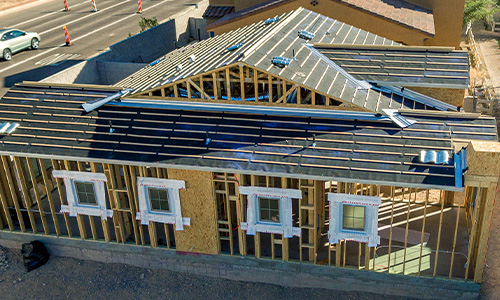Among the most important aspects of roofing is the roof underlayment layer. Roof underlayment acts as a shield, safeguarding your house against water infiltration and wind-driven rain. It’s the “weather-proofing” for your roof. Roof underlayment ensures that your roof, no matter which kind of roof it is, remains durable and your home remains dry and safe.
In this guide, we’ll discuss options for tile roof underlayment. We’ll explore the different types of underlayment available, their advantages, and disadvantages. Of course there’s no best underlayment for any roofing project, but we can help you access which underlayment is best for your specific needs.
What is Roof Underlayment, Exactly?
Roof underlayment is a protective layer installed between the roof deck and the visible roofing material. It acts as a secondary barrier against moisture, adding an extra layer of defense beneath the outer roofing layer. This extra layer offers additional protection against water infiltration, and wind-driven rain, as well as offering temporary protection while tiles are being replaced While roofs can be built without it, underlayment is an important secondary barrier to your home, and most building codes require it’s use.

There are several types of roof underlayment available, including traditional felt, synthetic materials like polyethylene or polypropylene, and peel-and-stick rubberized asphalt. We’ll discuss each one and which of them best meets your needs, budget, and climate.
Felt Roof Underlayment
Felt underlayment, also known as roofing felt or tar paper, is a common and time-tested material used in roofing. It is made from organic or fiberglass fibers saturated with asphalt, providing a waterproof and protective layer for the roof.
The Advantages of Felt Roof Underlayment
Felt underlayment is cost-effective, making it a popular choice for budget-conscious homeowners. It is easy to handle and install, making it a favorite among contractors. Additionally, it provides a certain level of breathability, allowing moisture to escape upwards from the roof decking.
- #1. Cost Effective
- #2. Breathable
- #3. Easy to Install
The Disadvantages of Felt Roof Underlayment

Despite its popularity, felt roof underlayment does have its drawbacks. It is less durable compared to some synthetic alternatives, making it susceptible to wear and tear over time. Felt can absorb water when exposed to monsoon storms, potentially leading to sagging and degradation. It also lacks the superior tear resistance of synthetic materials. Felt also doesn’t hold up very well against the extreme heat of Arizona either.
Felt roof underlayment is ideal for homeowners on a budget and for projects where cost is a significant concern. It is suitable for moderate climates with relatively low moisture levels. Felt roof underlayment is also a good choice for temporary weather protection during roof installations, especially outside of monsoon season. However, felt doesn’t hold up well against the intense heat, or the heavy monsoons expected by Arizona residents.
Synthetic Roof Underlayment
Synthetic roo funderlayment is a modern roofing material made from polypropylene or polyurethane. Unlike traditional felt, these materials are engineered to be lightweight, durable, and resistant to various weather conditions, including the intense sun and heavy rainfall.
The Advantages of Synthetic Roof Underlayment
Synthetic underlayment offers several advantages. Firstly, it is highly resistant to UV rays, ensuring that it doesn’t degrade under the intense desert sun. Its water-resistant properties are good for preventing damage during monsoon season. Synthetic underlayment is also tear-resistant, providing superior durability and protection against wind damage. Additionally, it is lightweight and easy to handle, making the installation process more efficient.
- #1. UV Resistant
- #2. Water Resistant
- #3. Tear Resistant
- #4. Long-Lasting
The Disadvantages of Synthetic Roof Underlayment
While synthetic underlayment has numerous advantages, it does have some limitations. One of the main concerns is the cost, as it is generally more expensive than traditional felt. However, many homeowners find that the long-term benefits outweigh the initial investment. Additionally, some synthetic materials might not be as breathable as felt, which could potentially trap moisture, if it’s not able to dissipate downwards.
Synthetic roof underlayment is ideal for Arizona homes due to its exceptional resistance to both intense sun and heavy rainfall. It is especially recommended for homes in areas prone to monsoons, where the ability to withstand sudden, heavy downpours is crucial. Additionally, synthetic underlayment is an excellent choice for homeowners seeking a long-lasting, low-maintenance solution for their roofs.
Rubberized Asphalt

Rubberized asphalt underlayment is made from asphalt mixed with rubber polymers, creating a flexible and waterproof material. This type of underlayment is a premium option with great protective abilities against many climates.
The Advantages of Rubberized Asphalt
Rubberized asphalt underlayment offers exceptional flexibility, allowing it to conform to the contours of the roof and creating a watertight seal. Its rubberized composition provides excellent resistance against the sun’s UV rays, ensuring longevity even in Arizona’s scorching heat. Furthermore, it boasts superior adhesion, reducing the risk of wind-driven rain infiltrating the roof. Most rubberized asphalt underlayments are peel-and-stick allowing easy installation and great sealing properties.
- #1. Easy Sealing
- #2. Water Resistant
- #3. UV Resistant
- #4. Easy to Install
The Disadvantages of Rubberized Asphalt
One of the 2 main drawbacks of rubberized asphalt underlayment is its weight. It is heavier than synthetic materials, which might pose challenges during installation. Additionally, its cost is relatively high as compared to traditional felt. However, its protection often justifies the investment for homeowners looking for a long-lasting solution, especially in difficult weather.
Rubberized asphalt underlayment is particularly suitable for homes in Arizona due to its ability to withstand extreme heat and heavy rainfall. It is an excellent choice for homeowners who prioritize durability and are willing to invest in a higher-end underlayment option.
Which Roof Underlayment Option Is Best For You?

The choice of roof underlayment depends on the specific circumstances of your home and the climate. For those seeking a budget-friendly option and don’t mind regular replacements, felt roof underlayment can be suitable. However, for homeowners looking for long-term durability and superior protection, especially in the face of Arizona’s intense sun and heavy monsoon rains, synthetic underlayment, particularly polypropylene and polyurethane variants, or rubberized asphalt, are highly recommended. These options offer superior resistance to UV rays, water, and wind, ensuring that your roof remains secure and your home protected.
- Felt Underlayment - Inexpensive, but doesn't last long.
- Synthetic Underlayment - More expensive than felt, but lasts the longest
- Rubberized Asphalt - Premium Price, but has the best protection
When you consider a roofing underlayment for your home, keep relevant factors in mind, such as climate, price, and durability. Remember, investing in quality roofing underlayment is an investment in the longevity and resilience of your home—a decision that will pay off for years to come. If you want an expert opinion feel free to call us at (602) 859-0496, or visit our roofing replacement page for more info!

